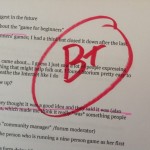A Meeting to Set OKRs
Setting OKRs is hard. It involves taking a hard look at your company, and it involves having a ton of difficult conversations about making choices about where the company should go.
Here’s how I run an OKR setting meeting with execs.
Keep the meeting small– 10 or fewer people if possible. It must include the Sr executive team. Take away phones and computers if at all possible. It will encourage people to move quickly and pay attention.
A few days before the meeting, solicit all the employees to submit the Objective they think the company should focus on. Be sure to give them a very small window to do it in, 24 hours is plenty. You don’t want to slow down your process, and in a busy company later means never.
Have someone (a consultant, the department heads) collect and bring forward the best & most popular ones.
Set aside 4.5 hours to meet. Two two-hour sessions, with 30 minute break. Your goal: cancel the second session. Be focused.
Each exec head should have an Objective or two in mind to bring to the meeting. Have the best employee-generated objectives written out on post-it notes, and have your execs add theirs. I recommend having a variety of sizes available, and use the large ones for the objectives. Cramped writing is hard to read.
Now have the team place the post-its up on the wall. Combine duplicates, and look for patterns that suggest people are worried about a particular goal. Combine similar Objectives. Stack rank them. Finally, narrow them down to three.
Discuss. Debate. Fight. Stack rank. Pick.
Depending on the team you have, you have either hit the break, or you have another hour left.
Next, have all the members of the exec team freelist as many metrics as they can think of to measure the Objective. Freelisting is a Design Thinking technique. It means to simple write down as many ideas on a topic as you can, one per post-it( I recommend the small ones for this exercise).
Freelisting is a far more effective way to brainstorm, and results in better and more diverse ideas. Give the team slightly more time than is comfortable, perhaps ten minutes.
Next, you will affinity map them. This is another Design Thinking technique. All it means is you group post-its with like post-its. If two people both write DAU (Daily Active Users), you can put those on top of each other. It’s like two votes for that metric. Dau, Mau, Wau are all engagement metrics, and you can put them next to each other. Finally, you can pick your three types of metrics.
I tend to write the KRs as X first, i.e. “X revenue” or “X acquisitions” or “X DAU” . It’s easier to first discuss what to measure, then what the value should be and if it’s really a “shoot for the moon” goal. One fight at a time, is my motto.
As a rule of thumb, I like a usage metric, a revenue metric and a satisfaction metric for my KRs, but obviously that won’t always be right. Try to find multiple different ways to measure success. For example, two revenue metrics means you might have an unbalanced approach to success. Focusing only on revenue can lead to employees gaming the system and developing short term approaches that can damage retention.
Next, set the values for the KRs. Make sure they really are “shoot for the moon” goals. You should have only 50% confidence you can make them. Challenge each other. Is someone sandbagging? is someone playing it safe? Is someone foolhardy? Now is the time for debate, not halfway through the quarter.
Finally, take 5 minutes to discuss the final OKR set. Is the Objective aspirational and inspirational? Do the KRs make sense? Are they hard? Can you live with this for a full quarter?
Tweak until they feel right. Then go live them.
 Previous Post
Previous Post Next Post
Next Post
